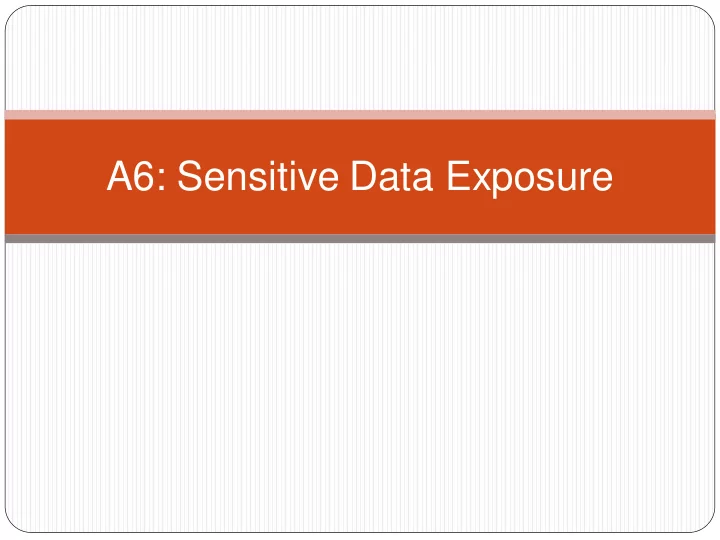

A6: Sensitive Data Exposure
A6 – Sensitive Data Exposure Sensitive data stored or transmitted insecurely Failure to protect all sensitive data Usernames, passwords, password hashes, credit-card information, identity info Session IDs, cookies Failure to protect all places sensitive data gets stored Databases, files, directories, log files, backups, etc. Failure to protect all transmissions of sensitive data Web, backend databases, business partners, internal communications
Example: Artifacts in source code Developers leaving secrets or tests in code API keys inside git repositories Comments by developers giving hints to hidden functionality (within HTML or code).
Example: Insecure Storage Victim enters credit 1 card number in form Bus. Functions Administration Communicatio Transactions E-Commerce Knowledge Accounts Finance Mgmt n Custom Code Log files Malicious insider 4 steals credit card Error handler logs CC 2 numbers details because merchant gateway is unavailable Logs are accessible to 3 all members of IT staff for debugging purposes
Example: Insecure Transport Business Partners External Victim Backend Systems Custom Code 1 Employees 2 External attacker steals Internal attacker credentials and steals credentials data off and data from network internal network External Attacker Internal Attacker Target 2013 breach, $252 million
Example: Poor use of cryptography Weak algorithms (Base64, MD5, AES-ECB Mode, RC4/SSL 3.0) Poorly used algorithms Pseudo-random number generators (PRNGs) with predictable seeds Unsalted cryptographic hashes Examples Guessable two-factor PIN codes Guessable password resets (e.g. generated passwords, reset links)
A6 – Prevention
Verify architecture Ensure threat model accounts for possible attacks Encrypt everything Encryption at rest All sensitive data All the places that data is stored Encryption in flight All times that data is communicated Cloud providers Default encryption at rest on most Backend communication calls all encrypted But, front-end is your responsibility (i.e. https)
Use algorithms appropriately Use standard strong algorithms Verify All keys, certificates, and passwords are securely generated, distributed, stored, and protected Effective plan for key change are in place Audit code the utilizes encryption code for common flaws (e.g. unsalted password hashes, uninitialized data)
Enable transport security Enable TLS for all connections HSTS (HTTP Strict Transport Security) HSTS Chrome preload list http://src.chromium.org/viewvc/chrome/trunk/src/net/http/ transport_security_state_static.json Employ certificate and public key pinning Key continuity to prevent rogue CA from redirecting your traffic WoSign 8/2016 Use the mechanisms correctly Disable old SSL algorithms (Poodle) http://www.owasp.org/index.php/Transport_Layer_Protection_Cheat _Sheet
Labs and homework Toy examples that don’t require topics in CS 485/585 to perform For more, take CS 485/585 Do the Matasano crypto challenges http://cryptopals.com
Lab Ruby walkthrough Break improper use of pseudo-random number generators to generate default passwords Code uses Ruby to generate password Seeds the random number generator with a constant Random.new(seed) Initial passwords are generated deterministically based on calls to the RNG One generated password and the order in which it was generated is known Attack Brute-force all seeds until a generated password matches your known password Reveals the seed Use position of known passwords to deduce password of first (admin) user
Lab Ruby example Code to generate random usernames Find the seeds that produce “ vwywbw ” or “ jozfbe ” as random_name for the following code s = Random.new(seed) random_name = 6.times.map{('a'..'z').to_a[s.rand(('a'..'z').to_a.size)]}.join Join chars to form username Repeat 6 times Create an array Generate random of length 6 out of lowercase index into array letters of lowercase characters Generate size of character array to select from
Lab Ruby walkthrough Find the seeds that produce “ vwywbw ” or “ jozfbe ” as the first username Invoke program as ruby InsecureCryptoStorage1.rb s = Random.new(seed) # Use PRNG to generate username # 6.times -> Generate 6 random characters # ('a'..'z').to_a -> Create array of lowercase letters # [s.rand(('a'..'z').to_a.size] -> Index letter array with random number between 0,25 random_name = 6.times.map{('a'..'z').to_a[s.rand(('a'..'z').to_a.size)]}.join print "Trying seed: ", seed, "\n" if (random_name == 'vwywbw') || (random_name == 'jozfbe') print "Found ",random_name," as first userid for seed: ",seed,"\ n“ print "MD5 hash of ",random_name," is ",Digest::MD5.hexdigest(random_name),"\n" seed=seed+1 else seed=seed+1 end end
Other helpful Ruby constructs Bounded ‘do’ loops 10.times do |i| puts i end Before starting, do these two loops have the same output? s = Random.new(0) 10.times do |i| 10.times do |i| s = Random.new(0) print i," ",s.rand(100),"\n" i.times{s.rand(100)} end print i," ",s.rand(100),"\n" end
Homework Insecure Cryptographic Storage Lesson echo – n Ym …GluZ0Zyb21Zb3U= | base64 -d Insecure Cryptographic Storage Challenge #1 Reverse-engineer a simple rotation cipher Insecure Cryptographic Storage Challenge #2 Reverse-engineer a multi-alphabetic substitution cipher (Vigenere) Use nodejs or Browser engine to execute JavaScript
Questions https://sayat.me/wu4f
Recommend
More recommend